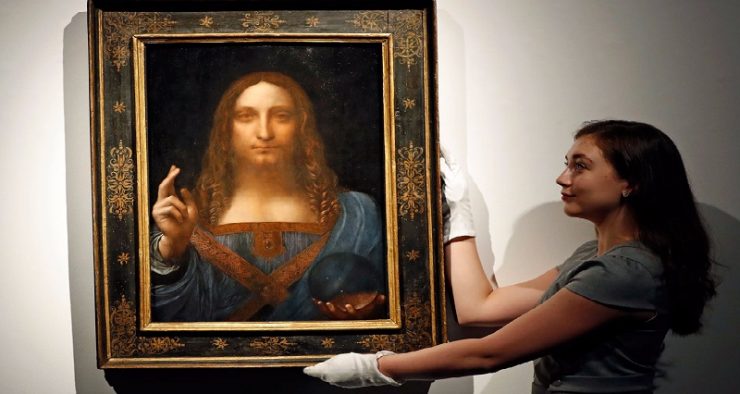FROM ONCE being sold for US$60 to being called “the greatest artistic rediscovery of the 21st century,” Leonardo da Vinci’s “Salvator Mundi” painting has captivated the attention of art lovers around the world once again
The 500-year-old portrait of Christ (the title means “Savior of the World” in Italian) sold for a record US$450.3 million at a Christie’s auction on Wednesday in New York City. The 16th-century work of art — which opened for bids at US$100,000 — is now officially the most expensive painting ever sold.
The auction lasted nearly 20 minutes and the final bid was US$400 million which, with fees, comes out at the recording breaking US$450 million figure. The new owner of the piece remains a mystery as they were a phone-in bidder.
The record was previously held by Pablo Picasso’s painting “Women of Algiers (Version O)” which was sold for US$179.4 million in May 2015. “Salvator Mundi” was previously owned by Russian billionaire Dmitry Rybolovlev, who bought it in 2013 for US$127.5 million in a private sale that became the subject of a continuing lawsuit, according to TIME.
Meanwhile The New York Times reported last week that the man behind the purchase was a little-known Saudi prince named Bader bin Abdullah bin Farhan al-Saud, an associate of Crown Prince Mohammed bin Salman.
Saudi Arabia has since said the prince was acting as a middleman for the United Arab Emirates, a key ally in the region.
“His Highness Prince Badr, as a friendly supporter of the Louvre Abu Dhabi, attended its opening ceremony on November 8th and was subsequently asked by the Abu Dhabi Department of Culture and Tourism to act as an intermediary purchaser for the piece,” the Saudi embassy in Washington said in a statement.
The Louvre Abu Dhabi is part of the emirate’s plans to diversify its economy away from oil. The government of Abu Dhabi said it had been eying the piece for a long time and felt it could not let this one get away.
“We had a strategy in mind, we worked very closely with the broker, we bid on it,” said Mohamed Al Mubarak, Chairman of the Department of Culture and Tourism. “We felt that in our lifetime we most likely will not see another da Vinci,” he told a conference in Abu Dhabi.
“Salvator Mundi,” which depicts Jesus Christ in Renaissance clothing, will be displayed alongside another da Vinci painting, “La Belle Ferronnière,” which is currently on loan from the Louvre in Paris.
Abu Dhabi has not yet said when “Salvator Mundi” will make its first appearance in its new home. Art experts expect it to become a huge draw.
“It is a coup for this one-month-old institution to welcome the world’s most expensive painting,” said Myrna Ayad, director of Art Dubai, an annual fair. “It’s wonderful to think that in a relatively short amount of time, the UAE has positioned itself as the region’s cultural capital.”
Countries across the region, including the UAE, Qatar and Saudi Arabia have been investing heavily in the arts and culture, building new museums and hosting exhibitions. That’s encouraging a new generation of art lovers.
Sotheby’s says the number of Middle Eastern clients participating in its global sales has risen by 76% over the past five years. The venerable auction house opened its first gallery in the region in Dubai in March. Christie’s, which has been in Dubai for more than a decade, has sold more than US$215 million worth of art since then.
Built on a man-made island in the UAE capital, the Louvre is part of the city’s drive to transform itself into a cultural hub. In a 30-year deal worth a reported €1 billion (US$1.18 billion), the French Louvre assists with exhibition management, offers advice and lends artworks to its Middle Eastern franchise. The new museum currently houses a permanent collection of 600 artworks, with a further 300 on loan from Paris.
Eager fans lined up outside Christie’s Rockefeller Center headquarters on Tuesday to view “Salvator Mundi.” Hundreds of people have viewed the painting at the venue, including Leonardo DiCaprio. [sources/photo special]
















